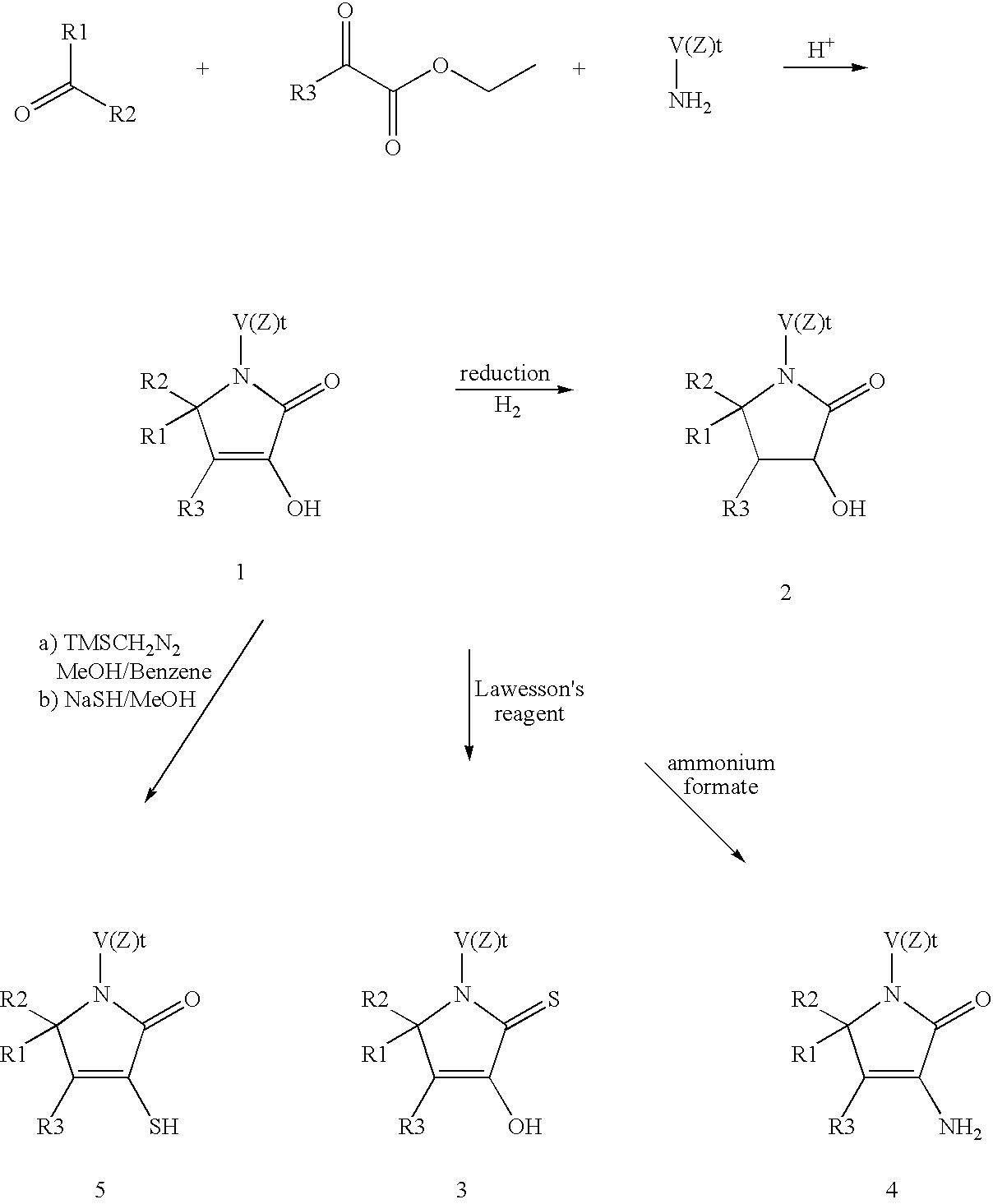Pyrrolidinone derivatives
a technology of pyrrolidinethione and pyrrolidinone, which is applied in the field of pyrrolidinones and pyrrolidinethiones and analogs, can solve the problems of complex biological functions mediated by these proteins, and achieve the effects of reducing the extravasation and tissue infiltration, enhancing localized infiltration of monocytes, and reducing the number of t cells
- Summary
- Abstract
- Description
- Claims
- Application Information
AI Technical Summary
Benefits of technology
Problems solved by technology
Method used
Image
Examples
example 1
Preparation of 4-acetyl-5-cyclohexyl-3-hydroxy-1-(4-methylphenyl)-1,5-dihydro-2H-pyrrol-2-one (compound 10).
To a stirring solution of p-toluidine (430 mg, 4.0 mmol) in 4 ml of acetic acid at room temperature, are added cyclohexane carboxaldehyde (450 mg, 4.0 mmol) and ethyl acetopyruvate (640 mg, 4.0 mmol). The reaction mixture is heated to 95° C., stirred for 120 minutes, cooled to room temperature and the solvent removed under reduced pressure. Diethyl ether (10 ml) is added to the residue and the mixture stirred for 30 minutes whereupon a white precipitate forms. The fmal compound is collected after filtration as a white crystalline solid mp 222° C. The filtrate may be concentrated to give additional compound.
1H NMR (300 MHz, CDCl3): δ 0.80-1.20 (m, 5H), δ 1.40-1.79 (m, 5H), δ 1.96 (m, 1H) δ 2.41 (s, 3H), δ 2.56 (s, 3H), 4.97 (d, 1H, J=0.9 Hz), 7.29 (m, 4H), 8.90 (s, br, 1H) ppm.
The racemic mixture can be resolved on a chiral HPLC column (Chiral Cel OD-H) using a mixture of...
example 2
Preparation of 1-(4-chlorophenyl)-5-cyclohexyl-3-hydroxy-4-[3-(4-hydroxyphenyl)propanoyl]-1,5-dihydro-2H-pyrrol-2-one (Compound 67)
To a stirring solution of 4-hydroxy benzyl acetone in 40 mL of dry DMF at room temperature, are added 0.96 g (40 mmol) of sodium hydride. The reaction mixture turns deep yellow and after 30 minutes diethyl oxalate (5.43 ml, 40 mmol) is added. The mixture is stirred overnight at room temperature, then quenched with HCl 10% and extracted with ethyl acetate. The organic layers are washed with water, dried over magnesium sulfate, filtered and the solvent is evaporated under reduced pressure. The formation of the desired ethyl 6-(4-hydroxyphenyl)-2,4-dioxohexanoate is checked by H1-NMR before being used further without purification.
To a stirring solution of p-chloraniline (320 mg, 2.5 mmol) in 2.5 mL of acetic acid at room temperature, are added cyclohexane carboxaldehyde (0.30 mL, 2.5 mmol) and ethyl 6-(4-hydroxyphenyl)-2,4-dioxohexanoate (618 mg, 2.5 m...
example 3
Preparation of 4-acetyl-5-cyclohexyl-3-amino-1-(4-methylphenyl)-1,5-dihydro-2H-pyrrol-2-one (compound 61).
A reaction mixture of 4-acetyl-5-cyclohexyl-3-hydroxy-1-(4-methylphenyl)-1,5-dihydro-2H-pyrrol-2-one (139 mg, 0.44 mmol) and ammonium formate (342 mg, 4.44 mmol) in ethanol (0.2M, 2.2 ml) is heated at reflux for 16 hours. The solvent is removed in vacuo to give a white residue. Water is added to the residue to dissolve some of the white solid leaving a sandy-coloured precipitate. This mixture is then filtered, washed with a small amount of diethyl ether and dried under high vacuum at room temperature to give a pale brown solid.
1H NMR (400 MHz, CDCl3): δ 10.07 (s, br, 1H), 7.36 (d, 2H), 7.22 (d,2H), 6.41 (s, br, 1H), 4.83 (d, 1H), 2.36 (s, 3H), 2.19 (s, 3H), 1.80-0.96 (m, 9H).
EXAMPLE 4
Preparation and enantiomeric resolution of 4-acetyl-1-(4-chloro-2-fluorophenyl)-5-cyclohexyl-3-hydroxy-1,5-dihydro-2H-pyrrol-2-one.
A. Preparation of 4-acetyl-1-(4-chloro-2-fluorophenyl)-5-c...
PUM
| Property | Measurement | Unit |
|---|---|---|
| Volume | aaaaa | aaaaa |
| Mass | aaaaa | aaaaa |
| Time | aaaaa | aaaaa |
Abstract
Description
Claims
Application Information
 Login to View More
Login to View More - R&D
- Intellectual Property
- Life Sciences
- Materials
- Tech Scout
- Unparalleled Data Quality
- Higher Quality Content
- 60% Fewer Hallucinations
Browse by: Latest US Patents, China's latest patents, Technical Efficacy Thesaurus, Application Domain, Technology Topic, Popular Technical Reports.
© 2025 PatSnap. All rights reserved.Legal|Privacy policy|Modern Slavery Act Transparency Statement|Sitemap|About US| Contact US: help@patsnap.com



